Greetings from Palmia Observatory
Well, here we are at another full day of presentations at the APS April Meeting in Denver, Colorado and first up on our brief review of some of the details is from the GRAVITY Collaboration.
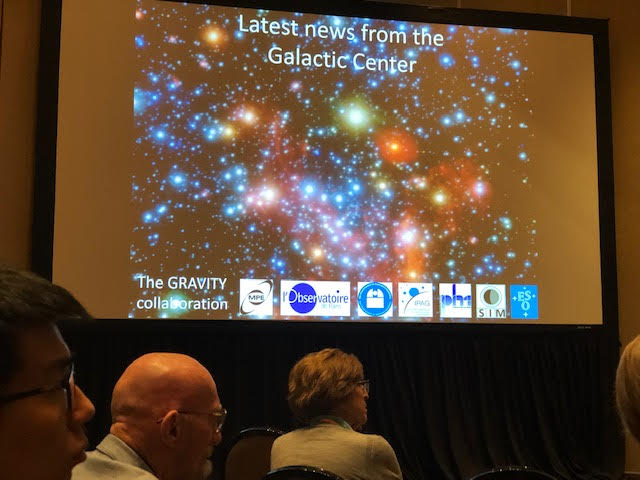 |
| Waiting, with Kip Thorne, for the Gravity Collaboration presentation at April APS Meeting in Denver |
Stefen Gillessen, Max Planck Institute, provided the details of the latest findings for the Gravity Collaboration.
 |
Stephen Gillessen, Gravity Collaboration at April APS Meeting in Denver (Source: Palmia Observatory)
|
The Gravity Collaboration collects data on the Very Large Telescope located in the Atacama desert near Paranal, Chile. This very large telescope operates as an interferometer and combines optical light from multiple, 8 meter telescopes to achieve much higher resolution.
 |
| The Very Large Telescope in Paranal, Chile (Source: Stefan Gillessen, Gravity Collaboration at APS Meeting in Denver) |
Interferometry is easier for radio telescopes because longer wavelengths makes adjusting the phase difference between scopes is not as difficult. The optical interferometric setup used for GRAVITY is outlined in the slide below.
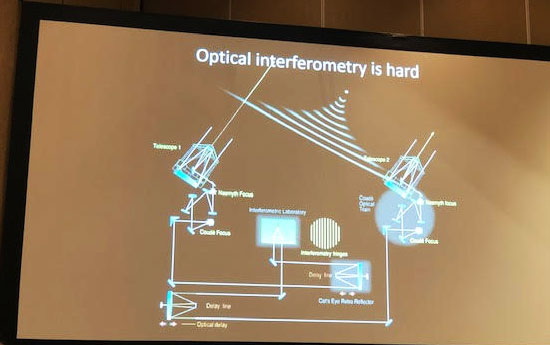 |
| Optical Interferometry at the Very Large Telescope (Source: Stefan Gillessen, Gravity Collaboration at APS Meeting in Denver) |
|
The 2 micrometer wavelength band is ideal for peering into the galactic center and the interferometric instrumentation is used to collect data in that band.
 |
| Best viewing at 2 um at Very Large Telescope (Source: Stefan Gillessen, Gravity Collaboration at APS Meeting in Denver) |
|
|
The combined optics of four telescopes and their distance separation enables the interferometer to achieve 3 milli-arcsecond resolution. A comparison showing the image resolution of 3 milli-arcseconds is shown in the slide below. That resolution would be able to see details as small as an automobile at distances to the moon.
 |
| Comparing angular resolution levels (Source: Stefan Gillessen, Gravity Collaboration at APS Meeting in Denver) |
This next slide was quite surprising. Now as most of you know, Romer was able to estimate the speed of light, to a pretty good degree of accuracy, by comparing the different transit times of eclipses of Jupiter's moon, Io, due to the Earth's position in its orbit about the sun, in 1676. So, here we are today, hearing about a similar measurement, not about the speed of light, but of the distance to the galactic center. This is a pretty neat concept, which I had not heard of before. Anyway, the following slide lays out the basics of the measurement.
 |
| Using the Romer method instead of radial velocity (Source: Stefan Gillessen, Gravity Collaboration at APS Meeting in Denver) |
Finally, Dr. Gillissen summarized some of the results already provided by the GRAVITY collaboration.
 |
| Summary slide from the Gravity Collaboration preentation (Source: Stefan Gillessen, Gravity Collaboration at APS Meeting in Denver) |
|
In another presentation session, Marcos Santander, U. of Alabama, talked about how scanning the high energy neutrino sky can help illuminate the source of cosmic rays.
 |
| Unveiling the Neutrino Sky (Source: Marcos Santander, U of Alabama, at APS April Meeting in Denver) |
Neutrinos are neutral particles and have low cross sections which limit their interactions with ordinary matter in the universe and because of this their path from point of generation to detectors here on Earth is more of a straight line than that for charged particles or ordinary matter. The slide below shows somewhat the possible tortuous path that a charged particle, like a cosmic ray, could follow depending on its interaction with the various galactic magnetic fields. Yet, the neutrinos, if they were also generated by whatever process was accelerating the cosmic rays, would mainly just propagate directly to our detectors. Of course they would still be subject gravitational lensing effects if any.
 |
| Neutrinos and Cosmic Rays (Source: Marcos Santander, U of Alabama, at APS April Meeting in Denver) |
|
Now as we have seen with other articles on neutrino detection, sometimes the angular resolution is not always good enough to help optical astronomers point their telescopes to the exact same position. It really helps when the source of neutrinos can be pinpointed to sufficient accuracy that the optical component from that same source can be measured. Well, the following slide shows how sometimes the moon can act as a shield or as an occultation so that the moon's transit can be accurately tied to the neutrino signal. Wow, that is pretty neat in that as optical astronomers we don't like the moon lighting up the sky, but here the moon blocking the signal is of great value.
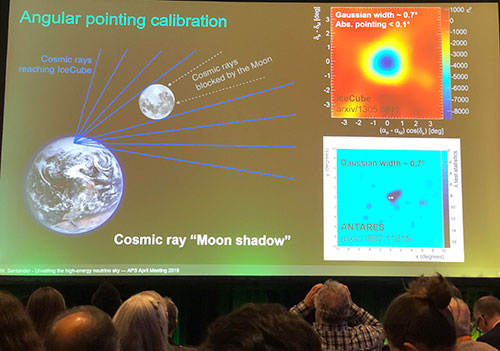 |
| Using the moon for angular calibration of sources on the sky (Source: Marcos Santander, U of Alabama, at APS April Meeting in Denver) |
Next Professor Santander showed the neutrino spectrum that we have seen before. The detection of the relic neutrino flux left over from the big bang is ongoing area of research. These neutrinos, although of large flux, are redshifted down to very low energy values. The high energy neutrino flux is shown in the blue shaded area on the chart. The neutrino flux is very much less in this region and therefore the detectors have to be much larger in order to even detect a neutrino event in a year or so.
 |
| Spectrum of high energy neutrino astrophysics (Source: Marcos Santander, U of Alabama, at APS April Meeting in Denver) |
|
Santander summarized the high energy neutrino search in the following summary slide. Thank you for bringing us up to speed, Professor Santander! We see here that we are definitely in the age of multi-messenger astronomy where optical, x-ray, gravitational waves and neutrinos, can be observed and if they all are generated from the same source, then a better understanding of the underlying physics can be obtained.
 |
| Summary slide for high energy neutrino astrophysics (Source: Marcos Santander, U of Alabama, at APS April Meeting in Denver) |
A separate neutrino presentation by Susanne Mertens, Technical University Munich (TUM) described one of the ongoing controversies in neutrino physics and that is if the neutrino is its own antiparticle. This type of neutrino, being its own antiparticle, is called a Majorana particle, after Ettore Majorana who theorized that these particles were possible in 1937. So, what evidence is there for the neutrino being its own antiparticle? None! But one ongoing experiment hopes to finally demonstrate the condition and it relies on the decay of some natural elements. Most of these decays called double beta decay, result in the release of two electrons and two neutrinos. This deacy happens in accordance with the half life of the radioactive isotope under consideration. But the Majorana theory says that every so often, every billion times or so, the decay reaction could be double electrons, but no release of neutrinos, because the neutrinos were annihilated as part of the decay process as outlined in the slide below. The neat thing about this decay path is that the resulting energy spectrum of the outgoing electrons is very well defined and can be more easily measured and distinguished from other background sources. Time will tell if this result is found in the laboratory or not. If it can be found, it will be an interesting aspect of physics and also help define the mass of the neutrino.
|
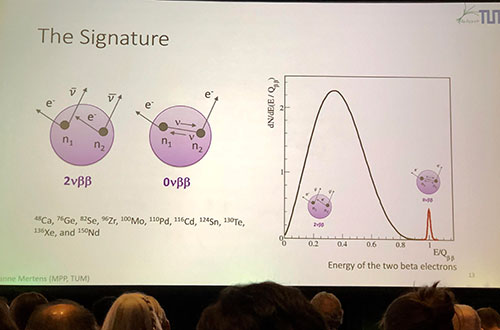 |
| Double beta, neutrino less decay if present has identifiable spectrum (Source: Susanne Mertens at APS Meeting in Denver) |
Next up for a brief summary is Elena Aprile, Columbia University, who is well known in the WIMP search community. The search for dark matter particles is difficult because they interact only slightly with ordinary mater and the background noise is so high that the dark matter detectors must be located far underground to limit the effects of background noise.
 |
| Status of search for WIMPs (Source: Elena Aprile presentation at APS Meeting in Denver) |
Elena is well recognized as an advocate of WIMPs as being the leading candidate for what constitutes dark matter. Hmm, the search has been going on for many years now and now results as experiment after experiment continues to exclude more and more of the energy spectrum where the WIMPS can be hiding. Check out the spectrum of possible forms of dark matter in the slide below. The range of energies covers more than 80 orders of magnitude. As we have seen in previous details explored in other sessions of the APS meeting, the other conceptual particles range from very light weight axions and neutrinos, to heavier versions of neutrinos, to even very heavy primordial black holes. We will have to wait and see what the final answer turns out to be!
 |
| WIMPs in middle of 80 orders of magnitude mass range (Source: Elena Aprile presentation at APS Meeting in Denver) |
|
|
Elena went on to describe how the search for WIMPs takes place. Given that they are supposed to have a certain mass, then one can calculate how many WIMP particles are necessary in order to match the value needed to explain the gravitational effects attributed to dark matter. This WIMP flux can then be used to size and select the type of detector to search for the elusive particles. See the slide below.
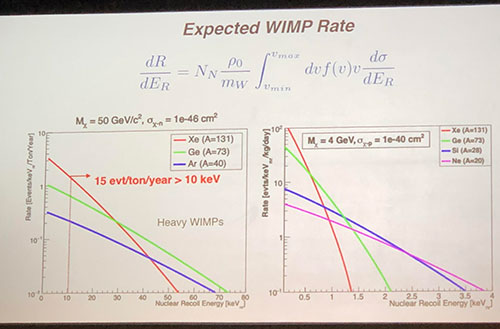 |
| Expected WIMP sets experiment design (Source: Elena Aprile presentation at APS Meeting in Denver) |
|
|
The next slide shows how different experiments keep carving off regions of the mass spectrum which have been ruled out and the particle has not been found in that region. Year after year the carved out area keeps growing and the experiments have to become more sensitive and larger in order to keep excluding other regions.
|
 |
| Ongoing WIMP searches keep excluding areas of hiding (Source: Elena Aprile presentation at APS Meeting in Denver) |
|
|
|
I have seen several of Elena's presentations over the years and I keep learning a little bit more each time, but the sad news is that the search just keeps going on with not much new good news. But as Elena says, "at least we know where WIMPS are not located."
 |
| Status of WIMP Search presentation summary slide (Source: Elena Aprile presentation at APS Meeting in Denver) |
Finally, we had an opportunity to get a little bit of culture at an APS sponsored event that was the staged reading of a play, Silent Sky, by playwright Lauren Gunderson. The play tells the story of Henrietta Leavitt, who after graduating with a mathematics background, and seeking and hoping to do something of significance in astronomy, is hired by Harvard University, as a "computer" to help analyze and catalog glass plates of star images. Of course at this time, women were not allowed anywhere near the actual telescope and we sequestered to do their work independently. The play and interaction among the other actors, includes her sister and two other computers and a fictional, nearly a love interest, who was their male observatory intern. Anyway, Henrietta's love desire to accomplish something of worthwhile, comes up with what turns out to be of key importance to establishing distance in astronomy, called the Cepheid variable luminosity period relations. I found the staged reading absolutely riveting and marvelous. Her work with Cepheid variables was the essential key that "male" astronomers could use to establish that other galaxies were far outside the Milky Way and that eventually the discovery that the universe was expanding. We owe such a debt to Henrietta for what she did for astronomy and for dealing with chauvinism so prevalent at the time, 1910-1920. Anyway, I was emotionally moved by the actors, who although only in a staged setting, were fantastic, and I really enjoyed the evening.
 |
| Staged reading of Silent Sky, about Henrietta Leavitt, at APS Meeting in Denver (Source: Palmia Observatory) |
Resident Astronomer George
Be sure to check out over 300 other blog posts on similar topics
If you are interested in things astronomical or in astrophysics and cosmology





















No comments:
Post a Comment